A New Year’s Retrospective thru Historic Newspapers…
December 31, 2013 by GuyHeilenman · Leave a Comment
Pinterest has certainly become a wonderful forum for sharing favorite pictures, recipes, ideas, and more. While most historic and rare newspapers are known more for content rather than images, illustrated newspapers, especially from the 19th and early 20th centuries, are quite striking. Below please find a link to a collection of such original newspapers centered around a New Year’s theme. Please enjoy.
A New Year’s Retrospective thru Historic Newspapers…
Gentleman’s Magazine: a little gem packed with history…
December 27, 2013 by TimHughes · Leave a Comment
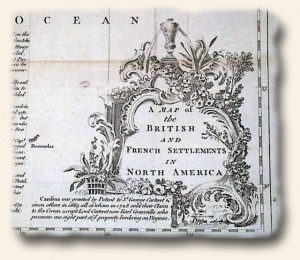
As dealers we have been very true to our focus on rare newspapers, and—for the most part—only newspapers. Yes, we have ventured into the occasional old document, pamphlet, colonial currency and the other items I’ve found intriguing, but otherwise we offer only historic newspapers.
But one big exception has been 18th century magazines. As is likely the case with most collectors of history, the over-riding aim is to find historic news reports dated as early as possible, and the availability of newspapers runs quite thin before 1760 (the London Chronicle dates to 1755 and is the single biggest source of period reports back to this period) if British titles are accepted, and only back to about 1787 if American newspapers are the only option.
It was many years ago that I discovered one of the best titles of the 18th century for period news reporting, and it wasn’t even a newspaper. It is a magazine. More specifically, “The Gentleman’s Magazine” from London. Having begun in 1731, its pages captured news reports concerning America which could never be found in period American newspapers, and rarely found in period British newspapers. From its earliest years “The Gentleman’s Magazine” printed reports on the creation of the colony of Georgia, the founding of the town of Savannah, with many issues mentioning James Olgethorpe. From 1736 are reports of William Penn laying out the city of Philadelphia, and the 1730’s has several reports of pirates operating in the Caribbean and the Atlantic, as well as famous highwayman Dick Turpin. Slave revolts in Jamaica, “Customs of the Jews” and other smaller reports from the American colonies round on the 1730’s.
The 1740’s have several items on the slavery issue which would be a topic of discussion on both sides of the Atlantic well into the 19th century. And relating to slavery are several issues of the 1770’s on famous slave/poet Phillis Wheatley.
There are early reports on the sport of cricket, and much on the Jacobite Rebellion including mention of “Bonnie Prince Charlie”. Other curious reports from the 1740’s include text on Handel and his “Messiah”, Ben Franklin mention with various electricity experiments, the death of astronomer Edmund Halley, the origin of the game of chess, and a curious item on a northwest passage to China through Canada. Military events in periodicals are never-ending, and this decade prints the text of the Treaty of Aix la Chapelle, among many other military events.
The 1750’s are highlighted by much reporting on the French & Indian War between the French & the British, with mention of Quebec, Crown Point, Fort DuQuesne and all the other major battle sites. Keep in mind that the American colonies were British possessions at the time so there was much interest in
“The Gentleman’s Magazine” has nice reporting on Ben Franklin’s lightening rod experiments, and there is also a terrific—although inconspicuous—mention of what would become known to all Americans as the Liberty Bell. Under the heading: “America” and with a “Philadelphia, May 10” dateline from 1753 is a report reading:

“Last week was raised and fixed, in the State-House Steeple, the great bell, weighing 2080 lb. cast here, with this inscription,
‘Proclaim liberty throughout all the land, to the inhabitants thereof.” This is how they reported the installation of what would become known as the Liberty Bell.England in reporting events relative to the colonies. A special feature of Gentleman’s was their very early mention of George Washington, a Major in the Virginia military in 1754 and 1755 when he lead others into battle in Pennsylvania. Such mention of Washington in an American newspaper would result in a price well beyond the budget of most collectors.
The 1760’s in “The Gentleman’s Magazine” are highlighted by the growing tensions between the colonies and England. The full text of the hated Stamp Act is found within its pages, and just a year later is found the formal repeal of the Stamp Act by the British King. Other Acts of Parliament harmful to colonial relations are reported as well.
News from the 1770’s begin with the Boston Massacre (and the trial details of those involved), reported in Gentleman’s in nice detail. All the events of the Revolutionary War received excellent coverage, from the Boston Tea Party to Lexington & Concord, the Battle of Bunker Hill, Saratoga, White Plains, Ticonderoga, Cowpens, Guilford Court House and the other military initiatives of the war with considerable mention of George Washington, Gage, Gates, Burgoyne, Ethan Allen, Howe, Greene, Cornwallis, John Paul Jones, and others. There is even much detail on the infamous Benedict Arnold/Major Andre treason.
Historic documents are found within the pages of “Gentleman’s Magazine” as well, including the Articles of Confederation, the “Causes & Necessity for Taking Up Arms”, the Constitution of the United States (in 1787), and the most desired document of all, the Declaration of Independence. At a time when a period printing of the Declaration in an American newspaper will sell for over a quarter of a million dollars, to be able to purchase a 1776 magazine with a timely printing of the Declaration of Independence for under $4000 is a rare opportunity for any collector.
The 1780’s begin with the closing events of the Revolutionary War, including the surrender of Cornwallis to Washington at Yorktown, Virginia, and shortly thereafter the formal text of the Treaty which ended the Revolutionary War. There are reports on Captain James Cook’s famous voyages of exploration, the obituary of Benjamin Franklin, and with attention focusing more on European reports later in the decade are reports of the fall of the Bastille and the French Revolution, and into the 1790’s with the mutiny on the Bounty, the guillotine execution of Louis XVI and Marie Antoinette, then into the early 19th century with the Battles of Trafalgar and Waterloo. Gentleman’s also printed the text of Washington’s final state-of-the-union address, and then just a few years later, his death.
A very nice bonus found in many of the pages of Gentleman’s is maps & plates. They cannot be found in newspapers of the day. Printed separately from the regular pages of the issue and tipped within, most of the maps fold out to be double the size of the issue, and they includes some of the more desired maps one would want of the 18th century, including Philadelphia, the colonies (from 1755), Pennsylvania, Connecticut, Rhode Island, the Caribbean, St. Augustine, the entire western hemisphere and so much more. Many collectors choose to frame the maps separate from the issue as they are very decorative and are typically dated in an upper corner.
Plates include the Philadelphia State House, later to be known as Independence Hall; St. Philip’s Church in Charleston, the fort at Bunker’s Hill, Ben Franklin’s ‘Square of Squares’, the guillotine which beheaded Louis XVI and his wife, a slavery medal, and even a plate of the Garden of Eden. Plus there is so much more.
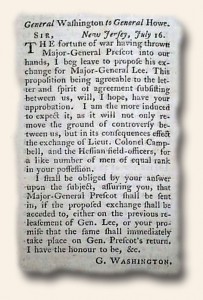
The “Gentleman’s Magazine” is a little gem packed with all the history one would want to find from the 18th century. Measuring about 5 by 8 inches and typically having about 40 pages they take up very little room in a collection. But best of all it is an accessible title, and at prices far below what would be found in comparable American & British newspapers of the same period.
There can be little excuse for holding back on buying the best events in American history if one is willing to add this famous & successful title to their collection. And there certainly will be a time when even this title will become very scarce as others discovery it as the little gem just begging to be collected.
Note: Rather than include an endless number of (annoying) links above, if you have interest in any of the topics discussed, simply go to the following link and enter the topic into the search field: www.RareNewspapers.com
A Christmas wish… 2013…
December 23, 2013 by GuyHeilenman · Leave a Comment
While Christmas is certainly a time when many who would not normally do so reflect on the spiritual, historic newspapers reveal a time when the lines between the spiritual and the physical were not nearly so distinct. Religion, while largely stripped from the currently public square, was part and parcel of daily conversation in the not to distant past. An example would be the following report of the importance of religion in the lives of Civil War soldiers found in the Hammond Gazette (Point Lookout, MD) of September 22, 1863. My Christmas wish is that we would regain our previous understanding of the role of true religion in everyday life, minus the driving harsh conditions of the past. Please enjoy.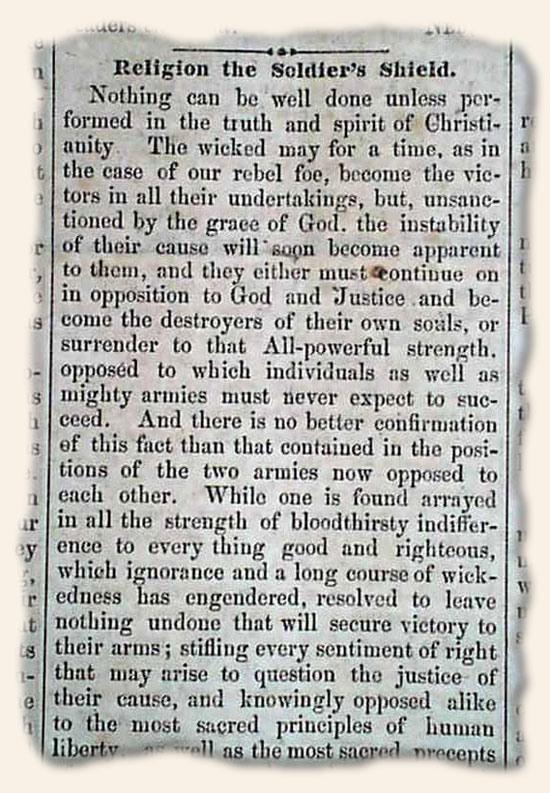
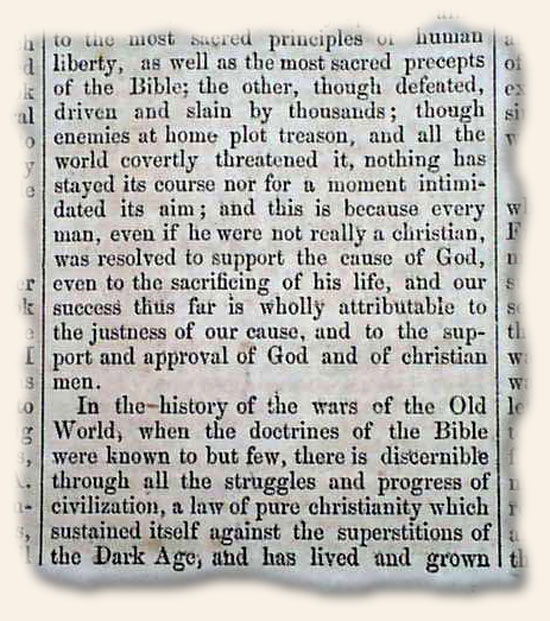
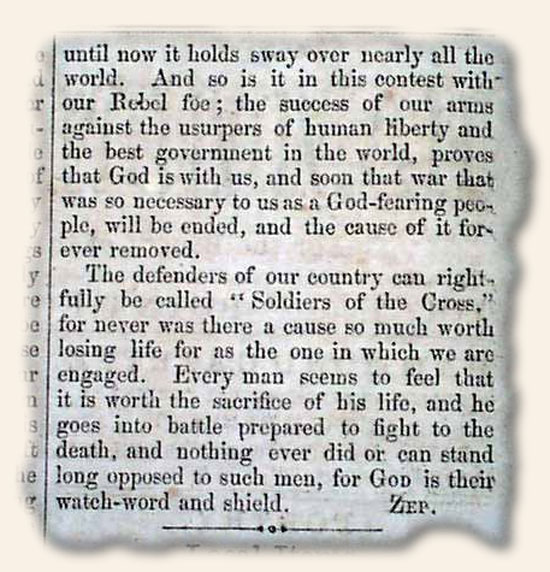
A good reason to stand & fight…
December 20, 2013 by TimHughes · Leave a Comment
The “Hammond Gazette” hospital newspaper from the Civil War, dated August 25, 1863, has an interesting front page item concerning the “Gray Beard Brigade” (see below) and why they are inclined to stand & fight. And also a likely reason why one of their elderly members joined the army.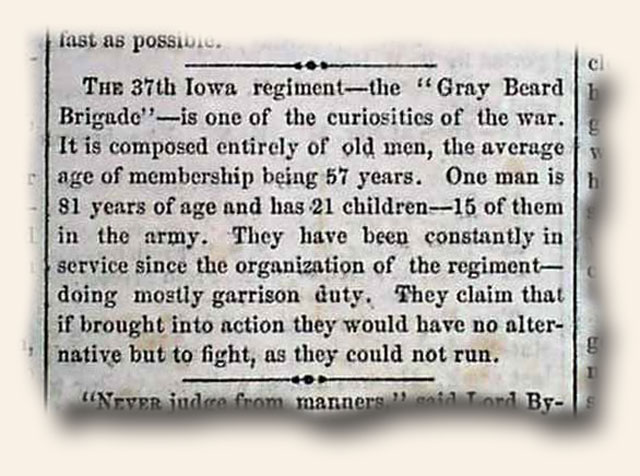
The Traveler… give all for son… radium for cancer… “yuletide and goodwill”…
December 16, 2013 by The Traveler · Leave a Comment
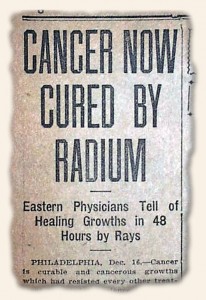 Today’s journeys brought me to San Francisco via The Call dated December 16, 1913. The reporting of General Terrazas being willing to offer himself as a human sacrifice to General Villa for his son. This was in regards to General Villa’s treatment to the people in Chihuahua.
Today’s journeys brought me to San Francisco via The Call dated December 16, 1913. The reporting of General Terrazas being willing to offer himself as a human sacrifice to General Villa for his son. This was in regards to General Villa’s treatment to the people in Chihuahua.
The back page of the issue had a report “Cancer Now Cured by Radium”. “…The power of the rays of radium over cancer is not only wonderful, it is appalling almost unbelievable…”.
The front page contains an article pertaining to the recently recover Mona Lisa painting and an interesting story of an undertaker that was arrested for beating a man that blocked a funeral procession.
In closing, the “Christmas Ship Brings ‘Yuletide and Goodwill'” relates of three passengers on the list of the Anchor line steamer California. They were the Rev. James Yule, Robert Tide and Miss Helen Goodwill.
I wish health and happiest to all. Merry Christmas!
~ The Traveler
A lament of a dying soldier…
December 13, 2013 by TimHughes · Leave a Comment
Occasionally the human side of war comes through in the newspapers of the day, giving hard evidence of the tragedy of lost life and how it affects those back home. The front page of the: “Hammond Gazette” from Point Lookout, Maryland, Jan. 27, 1864, contains a poem titled “Who Will Care for Mother Now?” (see below) It reflects the sorrows & concerns of a dying soldier, and obviously attracted much attention as the internet is full of references to this poem, which at some point was to music as well.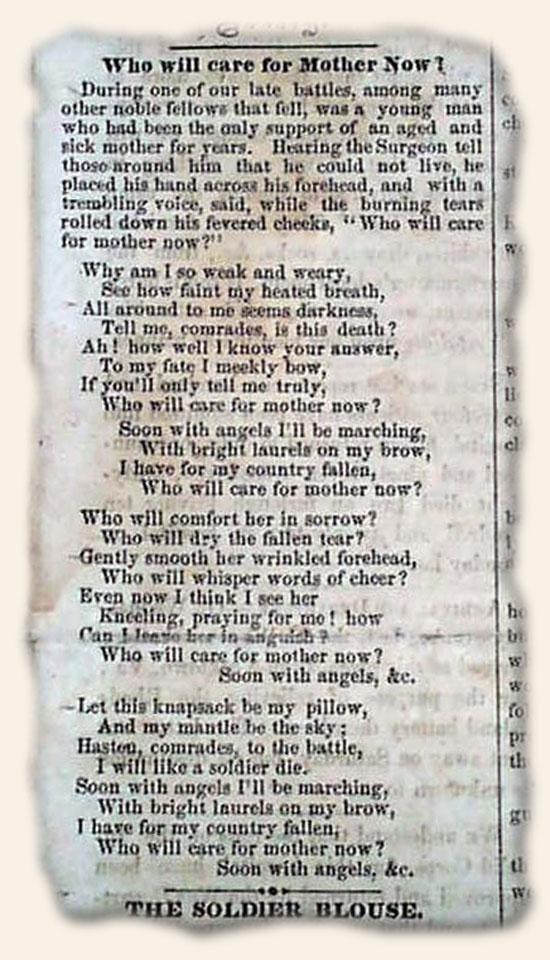
Soldier gets a “Dear John” letter…
December 9, 2013 by TimHughes · Leave a Comment
The tragedies of the Civil War touched many facets of life, from the pain & hardships of the soldiers to dealing with the loss of loved ones. The war affected the love lives of many as well, as evidenced by this letter found in the “Hammond Gazette” hospital newspaper from Point Lookout, Maryland, September 15, 1863.
What about three wrongs making a right?
December 6, 2013 by GuyHeilenman · Leave a Comment
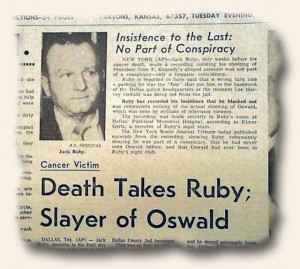 Finishing out our month-long tribute to the memory of John F. Kennedy, today we look at what may have been the closing chapter of the tragic death-sequence which began on November 22, 1963 with the assassination of JFK, advanced to November 23, 1963 with the shooting and death of Lee Harvey Oswald, and culminated on January 3, 1967 with the passing of death-row inmate, Jack Ruby. Many to this day are convinced that all three deaths are rife with conspiracy. Perhaps time will prove them to be correct.
Finishing out our month-long tribute to the memory of John F. Kennedy, today we look at what may have been the closing chapter of the tragic death-sequence which began on November 22, 1963 with the assassination of JFK, advanced to November 23, 1963 with the shooting and death of Lee Harvey Oswald, and culminated on January 3, 1967 with the passing of death-row inmate, Jack Ruby. Many to this day are convinced that all three deaths are rife with conspiracy. Perhaps time will prove them to be correct.
Finding newspapers on the death of Ruby are quite difficult as the event was not deemed significant by most, and many institutions were no longer saving their newspapers for year-end binding – choosing instead to store them on microfiche to conserve precious storage space. However, every now and then one turns up. Please enjoy (?) the January 3, 1967 report as it appeared in The Parsons Sun (Kansas): The Death of Jack Ruby
The Traveler… a proclamation with a fishy smell to it…
December 2, 2013 by The Traveler · Leave a Comment
 Today I journeyed to Boston through the Boston Gazette of December 2, 1813. There I found numerous reports pertaining to the Battle of Chrysler’s [Crysler’s] farm. Within this one issue is the “American Un-Official Accounts”, the “British Official Accounts” and the “American Official Accounts”. This battle took place on November 11th between the British under the command of Lieut. Col Morrison and Canadian under the of command Capt. Mulcaster against the Americans under the command of Maj. Gen. Wilkinson, fighting on both land and on waters. The American troops encountered a high number of injuries and deaths “…The dead rest in honor, and the wounded bled for their country and deserve its gratitude…”.
Today I journeyed to Boston through the Boston Gazette of December 2, 1813. There I found numerous reports pertaining to the Battle of Chrysler’s [Crysler’s] farm. Within this one issue is the “American Un-Official Accounts”, the “British Official Accounts” and the “American Official Accounts”. This battle took place on November 11th between the British under the command of Lieut. Col Morrison and Canadian under the of command Capt. Mulcaster against the Americans under the command of Maj. Gen. Wilkinson, fighting on both land and on waters. The American troops encountered a high number of injuries and deaths “…The dead rest in honor, and the wounded bled for their country and deserve its gratitude…”.
Also included is a proclamation from *Maj. Gen. Wilkinson. “…Those, therefore, among you who remain quiet at home, should victory incline to the American standard, shall be protected in their persons and property — But those who are found in arms must necessarily be treated as avowed enemies. To menace is unmanly — to seduce dishonorably — Yet it is just and humane to place these alternatives before you…”. If one didn’t know better, this proclamation sounds as if it may have come from a non-American General (see note below).
~The Traveler
*Background (wiki): James Wilkinson (March 24, 1757 – December 28, 1825) was an American soldier and statesman, who was associated with several scandals and controversies. He served in the Continental Army during the American Revolutionary War, but was twice compelled to resign. He was twice the Commanding General of the United States Army, appointed first Governor of the Louisiana Territory in 1805, and commanded two unsuccessful campaigns in the St. Lawrence theater during the War of 1812. After his death, he was discovered to have been a paid agent of the Spanish Crown.


